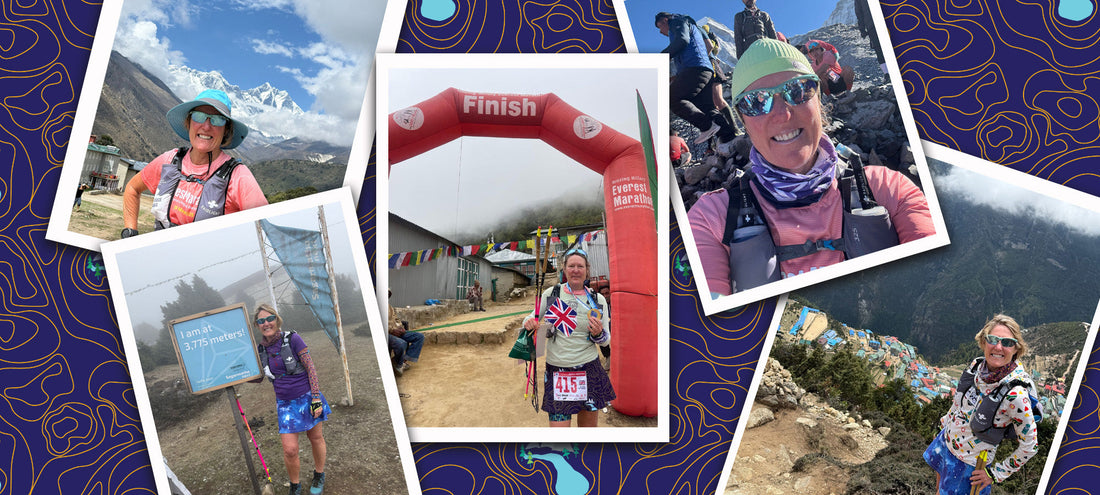
Yaks, Switchbacks, and Skorts: My Everest Marathon Story
Yaks, Switchbacks, and Skorts: My Everest Marathon Story
For years, the Everest Marathon has been sitting on my bucket list - one of those “maybe one day” challenges that seemed a little bit mad but also irresistible. On 29th May, I finally ticked it off. Why that date? It marks the anniversary of Tenzing Norgay and Edmund Hillary summiting the world’s highest mountain. It felt like the perfect time to take on a marathon that starts at Everest Base Camp!
The adventure began with a flight from Kathmandu to Lukla - widely regarded as the world’s most dangerous airport - followed by a 12-day acclimatisation trek to Everest Base Camp. Lukla sits at 2,860m (9,383 ft), and base camp is at a whopping 5,364m (17,598 ft). The trail varied wildly: stone paths, forest tracks, boulder scrambles, and Indiana Jones rope bridges strung across deep valleys with icy glacial rivers below.
The trail was busy with hikers, Sherpas, and local porters carrying everything imaginable - from sacks of rice to flat-pack furniture and even 65” TVs. Yaks and donkeys barrelled along narrow ledges, bells jangling, carrying everything from gas cylinders to bottled water. If you're not paying attention, they will absolutely nudge you off the edge - and with no safety barriers, a misstep could be catastrophic. Definitely not ideal for anyone with vertigo!
Accommodation en route came in the form of basic tea houses - simple brick buildings divided into plywood cubicles. You could hear a flea fart three rooms down, so privacy is minimal. Shared bathrooms (flush loos rare, hot water rarer) were the norm, and showers cost extra. Meals were basic but hearty: think lots of rice, curry, pasta, chips, cauliflower, and carrots. If you're picky, you'll struggle.
Most mornings started around 5:30am with departure around 7. Thanks to the altitude, we were completely wiped by the evenings - bedtime was often 8pm!
Despite being fit, I was amazed by how hard altitude hits. Even climbing a flight of stairs left me breathless. Progress was slow - think 1km per hour. Really. Steep ascents often took two to three hours, and we tackled endless switchbacks. The weather was sunny and warm in the day, freezing cold at night. We didn’t even glimpse Everest until Day 8 - it hides in the range, surrounded by other giants, and it's hard to grasp just how high it towers over everything.
Base Camp itself was… well, let’s say it was interesting. We arrived at the end of the climbing season, so it was relatively quiet. Most of the tents belonged to the 250 or so ultramarathon and marathon runners, along with their support teams. Everything - food, water, toilets (a barrel with a plastic bag inside), tents - is flown or carried in, and must be removed afterwards. Base Camp looked more like a quarry than an icy wonderland. The surroundings were stunning, but the camp itself? Not so much. Oh, and the toilets by race day? Truly grim. 🤮
We had snow while camped, so race morning was properly cold. Up at 5:30am for a 7:30 start, I proudly wore my Peaks & Patterns skort (of course) along with the official race T-shirt - required so they could spot us on the trail.
You might think it’s all downhill from Base Camp to the finish line at Namche Bazaar. Nope. The course is relentlessly hilly, with one final climb of 600m at mile 23. That one hurt. You’d also think breathing would get easier as you descend. Also nope. 😮💨
My goal time was 10 hours, so I was absolutely chuffed with 10:03. I wasn’t last - finished 142nd out of 216, which includes runners who didn’t make the start line due to altitude sickness. I was also one of the oldest participants, and (I think!) the oldest Brit there. If I can do something like this, then you can get out there too, whatever adventure you have in mind. That'd be awesome.
Would I do it again? No. 🤣 Did I enjoy it? Totally. 🔥🔥🔥
It was the toughest standard length marathon I’ve ever done, but what an incredible adventure. I feel genuinely blessed to have experienced it.



